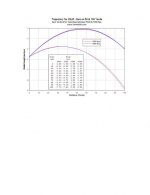On a couple of other forums I have been reading the debates between the two camps and have found it extremely interesting and entertaining. Now being of a low tech mind kind of guy I have come up with an old fashion type of test. I do not have the facility or the "killer" rifle to do the test, that is a rifle that will shoot .200 groups or less all day every day and a 200 yard indoor range but somewhere someone might.
So, if the muzzle is "stopped" then at 200 yards the difference in drop between ammo at 1085fps and ammo at 1035fps should be 4 inches if the ballistics calculator I used is correct, using a BC of .150. Under no circumstances should there be vertical spread of the two different speeds of ammo of less than that possible unless there is an error in the ballistic calculator. I understand that there are inconsistencies in ammo however one should still come out with a very elongated group of around 4 inches high and an inch wide. Round groups should be totally out of the question. Also if the muzzle is truly stopped this must be the absolute maximum accuracy setting at both 50 yards and 200 yards for the theory to work, no readjusting of the muzzle device should make it any better.
The test for " positive compensation" of course is if the muzzle device can be changed to be able to shoot a round group. If that happens then some sort of movement must be happening causing the slower bullets to hit higher on the target falling into the same group as the faster bullets. Now whether this is movement of the muzzle, change in departure angle of some other type of movement is for folks more clever than I to discern.
Anyone got stuff to actually do the test?
Dennis
So, if the muzzle is "stopped" then at 200 yards the difference in drop between ammo at 1085fps and ammo at 1035fps should be 4 inches if the ballistics calculator I used is correct, using a BC of .150. Under no circumstances should there be vertical spread of the two different speeds of ammo of less than that possible unless there is an error in the ballistic calculator. I understand that there are inconsistencies in ammo however one should still come out with a very elongated group of around 4 inches high and an inch wide. Round groups should be totally out of the question. Also if the muzzle is truly stopped this must be the absolute maximum accuracy setting at both 50 yards and 200 yards for the theory to work, no readjusting of the muzzle device should make it any better.
The test for " positive compensation" of course is if the muzzle device can be changed to be able to shoot a round group. If that happens then some sort of movement must be happening causing the slower bullets to hit higher on the target falling into the same group as the faster bullets. Now whether this is movement of the muzzle, change in departure angle of some other type of movement is for folks more clever than I to discern.
Anyone got stuff to actually do the test?
Dennis


